Effect of Manganese Concentration and Calcination Temperature on Photochemical Properties of TiOF2/MnO(OH)
Featured Application
Abstract
1. Introduction
2. Materials and Methods
2.1. Reagents
2.2. Synthesis of TiOF2
2.3. Synthesis of TiOF2/MnO(OH) Structures
2.4. Photocatalytic Tests
2.5. Equipment Used in the Research
3. Results
3.1. Synthesis of TiOF2/MnO(OH) Heterostructure
3.2. Effect of the Calcination Temperature
3.3. Photocatalytic Activity
4. Conclusions
Author Contributions
Funding
Institutional Review Board Statement
Informed Consent Statement
Data Availability Statement
Conflicts of Interest
References
- Kowalkińska, M.; Keller, N.; Fresno, F.; Colbeau-Justin, C.; Zielińska-Jurek, A. Insight into charge carrier dynamics and interface design of {001} TiO2 coupled with TiOF2 for photocatalytic degradation of contaminants of emerging concern. Appl. Surf. Sci. 2025, 695, 162893. [Google Scholar] [CrossRef]
- Liu, Y.; Ma, Z. TiOF2/g-C3N4 composite for visible-light driven photocatalysis. Colloids Surf. A Physicochem. Eng. Asp. 2021, 618, 126471. [Google Scholar] [CrossRef]
- Yu, J.; Tang, Q.; Liu, Y.; Zhu, Y.; Zhang, J.; Wang, J.; Li, L. Construction of TiO2/TiOF2 heterojunction as a cathode material for high-performance Mg2+/Li+ hybrid-ion batteries. J. Colloid Interface Sci. 2023, 646, 587–596. [Google Scholar] [CrossRef] [PubMed]
- Sivapatarnkun, J.; Hathaisamit, K.; Pudwat, S. High photocatalytic activity of F-TiO2 on activated carbon. Mater. Today Proc. 2017, 4, 6495–6501. [Google Scholar] [CrossRef]
- Lv, K.; Yu, J.; Cui, L.; Chen, S.; Li, M. Preparation of thermally stable anatase TiO2 photocatalyst from TiOF2 precursor and its photocatalytic activity. J. Alloys Compd. 2011, 509, 4557–4562. [Google Scholar] [CrossRef]
- Palliyalil, A.V.; Ullattil, S.G. TiO2 mesocrystals: Recent progress in synthesis, structure, and photocatalytic applications. Adv. Compos. Hybrid Mater. 2025, 8, 279. [Google Scholar] [CrossRef]
- Chen, Y.; Wang, X.; Zeng, Z.; Lv, M.; Wang, K.; Wang, H.; Tang, X. Towards molecular understanding of surface and interface catalytic engineering in TiO2/TiOF2 nanosheets photocatalytic antibacterial under visible light irradiation. J. Hazard. Mater. 2024, 465, 133429. [Google Scholar] [CrossRef]
- Hou, C.; Niu, M.; Hao, J.; Liu, Q.; Wang, X.; Zhang, M.; Wang, L. Construction of an S-scheme g-C3N4/TiOF2 Heterostructures with abundant O vacancies: Enhanced photocatalytic activity and mechanism insight. J. Alloys Compd. 2023, 938, 168560. [Google Scholar] [CrossRef]
- Sofronov, D.S.; Lebedynskiy, O.M.; Rucki, M.; Frolova, L.A.; Mateychenko, P.V.; Minenko, S.S.; Stawarz, S. A study on synthesis of TiOF2/CuO particles via impregnation method and their further transformation to F-TiO2/CuO. Mater. Sci. Eng. B 2025, 314, 118027. [Google Scholar] [CrossRef]
- Barreca, D.; Gri, F.; Gasparotto, A.; Altantzis, T.; Gombac, V.; Fornasiero, P.; Maccato, C. Insights into the plasma-assisted fabrication and nanoscopic investigation of tailored MnO2 nanomaterials. Inorg. Chem. 2018, 57, 14564–14573. [Google Scholar] [CrossRef]
- Mondal, D.; Das, S.; Paul, B.K.; Bhattacharya, D.; Ghoshal, D.; Gayen, A.L.; Das, K.; Das, S. Size engineered Cu-doped α-MnO2 nanoparticles for exaggerated photocatalytic activity and energy storage application. Mater. Res. Bull. 2019, 115, 159–169. [Google Scholar] [CrossRef]
- Shaly, A.A.; Priya, G.H.; Matharasi, A.; Prabha, A.S.; Linet, J.M. The nature and role of α-MnO2 nanowires in the photocatalytic degradation of the antibiotic tetracycline. Mater. Today Proc. 2022, 68 Pt 3, 282–286. [Google Scholar] [CrossRef]
- Kovinchuk, I.; Haiuk, N.; Lazzara, G.; Cavallaro, G.; Sokolsky, G. Enhanced photocatalytic degradation of PE film by anatase/γ-MnO2. Polym. Degrad. Stab. 2023, 210, 110295. [Google Scholar] [CrossRef]
- Ullah, A.; Rahman, L.; Hussain, S.Z.; Abbas, W.; Tawab, A.; Jilani, A.; Bajwa, S.Z.; Khan, W.S.; Riaz, R.; Hussain, I.; et al. Mechanistic insight of dye degradation using TiO2 anchored α-MnO2 nanorods as promising sunlight driven photocatalyst. Mater. Sci. Eng. B 2021, 271, 115257. [Google Scholar] [CrossRef]
- Li, M.; Wang, Y.; Fan, Y.; Liao, L.; Zhou, X.; Mo, S.; Wang, H. Controllable synthesis various morphologies of 3D hierarchical MnOx-TiO2 nanocatalysts for photothermocatalysis toluene and NO with free-ammonia. J. Colloid Interface Sci. 2022, 608 Pt 3, 3004–3012. [Google Scholar] [CrossRef]
- Li, X.; Wang, J.; Xue, H.; Zhao, L.; Lu, J.; Zhang, H.; Yan, M.; Deng, F.; Hu, C. Tuning α-MnOOH Formation via Atomic-Level Fe Introduction for Superior OER Performance. Adv. Funct. Mater. 2025, 35, 2503360. [Google Scholar] [CrossRef]
- Sofronov, D.; Krasnopyorova, A.; Efimova, N.; Oreshina, A.; Bryleva, E.; Yuhno, G.; Lavrynenko, S.; Rucki, M. Extraction of radionuclides of cerium, europium, cobalt and strontium with Mn3O4, MnO2, and MnOOH sorbents. Process Saf. Environ. Prot. 2019, 125, 157–163. [Google Scholar] [CrossRef]
- Arya, P.; Singh, A.; Singh, I.B. Facile Synthesis of Manganese Oxyhydroxide (MnOOH) Nanowires for the Capacitors Application. Appl. Innov. Res. 2019, 1, 58–61. [Google Scholar]
- Zhao, S.; Zhou, M.; Ren, J.; Zhang, Y.; He, Y.; Wang, R. Synthesis of MnOOH-hydroxyapatite nanowires for degradation of tetracycline. J. Environ. Chem. Eng. 2023, 11, 111577. [Google Scholar] [CrossRef]
- Ren, Z.; Che, X.; Wang, Q.; Zhang, F.; Han, J.; Zhou, C.; Liang, L.; Zhu, J.; Li, Z.; Li, G.; et al. RuO2/MnOOH heterojunctions promotes the formation of high-valent metal-oxo species for ultrafast removal of organic pollutants. Appl. Catal. B Environ. Energy 2025, 371, 125176. [Google Scholar] [CrossRef]
- Zheng, J.Y.; Zhou, K.L.; Zhao, W.K.; Wang, Y.; He, J.; Wang, X.; Wang, H.; Yan, H.; Han, C.B. Enhanced the synergistic degradation effect between active hydroxyl and reactive oxygen species for indoor formaldehyde based on platinum atoms modified MnOOH/MnO2 catalyst. J. Colloid Interface Sci. 2022, 628 Pt B, 359–370. [Google Scholar] [CrossRef]
- Sui, S.; Zhang, P.; Zhang, H.; Cao, R. Low-temperature catalytic degradation of the odorous pollutant hexanal by γ-MnOOH: The effect of Mn vacancies. Chin. J. Catal. 2019, 40, 1525–1533. [Google Scholar] [CrossRef]
- Sofronov, D.S.; Lebedynskiy, O.M.; Rucki, M.; Mateychenko, P.V.; Minenko, S.S.; Shaposhnyk, A.M.; Krzysiak, Z. A novel method of TiOF2 particles synthesis out of fluoride solutions. J. Alloys Compd. 2023, 966, 171646. [Google Scholar] [CrossRef]
- Sofronov, D.; Rucki, M.; Varchenko, V.; Bryleva, E.; Mateychenko, P.; Lebedynskiy, A. Removal of europium, cobalt and strontium from water solutions using MnO(OH)-modified diatomite. J. Environ. Chem. Eng. 2022, 10, 106944. [Google Scholar] [CrossRef]
- Shian, S.; Sandhage, K.H. Hexagonal and cubic TiOF2. J. Appl. Crystallogr. 2010, 43, 757–761. [Google Scholar] [CrossRef]
- Kovačič, Ž.; Likozar, B.; Huš, M. Electronic properties of rutile and anatase TiO2 and their effect on CO2 adsorption: A comparison of first principle approaches. Fuel 2022, 328, 125322. [Google Scholar] [CrossRef]
- Lin, C.-J.; Yang, W.-T. Ordered mesostructured Cu-doped TiO2 spheres as active visible-light-driven photocatalysts for degradation of paracetamol. Chem. Eng. J. 2014, 237, 131–137. [Google Scholar] [CrossRef]
- Dozzi, M.V.; D’Andrea, C.; Ohtani, B.; Valentini, G.; Selli, E. Fluorine-doped TiO2 materials: Photocatalytic activity vs timeresolved photoluminescence. J. Phys. Chem. C 2013, 117, 25586–25595. [Google Scholar] [CrossRef]
- Dariani, R.S.; Esmaeili, A.; Mortezaali, A.; Dehghanpour, S. Photocatalytic reaction and degradation of methylene blue on TiO2 nano-sized particles. Optik 2016, 127, 7143–7154. [Google Scholar] [CrossRef]
- Wang, Y.; Zhang, Y.; Liu, Y.; Wu, Z. Fluorine-induced oxygen vacancies on TiO2 nanosheets for photocatalytic indoor VOCs degradation. Appl. Catal. B Environ. 2022, 316, 121610. [Google Scholar] [CrossRef]
- Göktaş, S. Synergic effects of pH, reaction temperature, and various light sources on the photodegradation of methylene blue without photocatalyst: A relatively high degradation efficiency. Chem. Afr. 2024, 7, 4425–4437. [Google Scholar] [CrossRef]
- Frolova, L.A.; Khmelenko, O.V. The study of Co–Ni-Mn ferrites for the catalytic decomposition of 4-nitrophenol. Catal. Lett. 2021, 151, 1522–1533. [Google Scholar] [CrossRef]
- Zhang, Y.; Wu, M.; Wang, Y.; Kwok, Y.H.; Pan, W.; Szeto, W.; Huang, H.; Leung, D.Y.C. Fluorinated TiO2 coupling with α-MnO2 nanowires supported on different substrates for photocatalytic VOCs abatement under vacuum ultraviolet irradiation. Appl. Catal. B Environ. 2021, 280, 119388. [Google Scholar] [CrossRef]
- Sonu, K.; Puttaiah, S.H.; Raghavan, V.S.; Gorthi, S.S. Photocatalytic degradation of MB by TiO2: Studies on recycle and reuse of photocatalyst and treated water for seed germination. Environ. Sci. Pollut. Res. 2021, 28, 48742. [Google Scholar] [CrossRef] [PubMed]
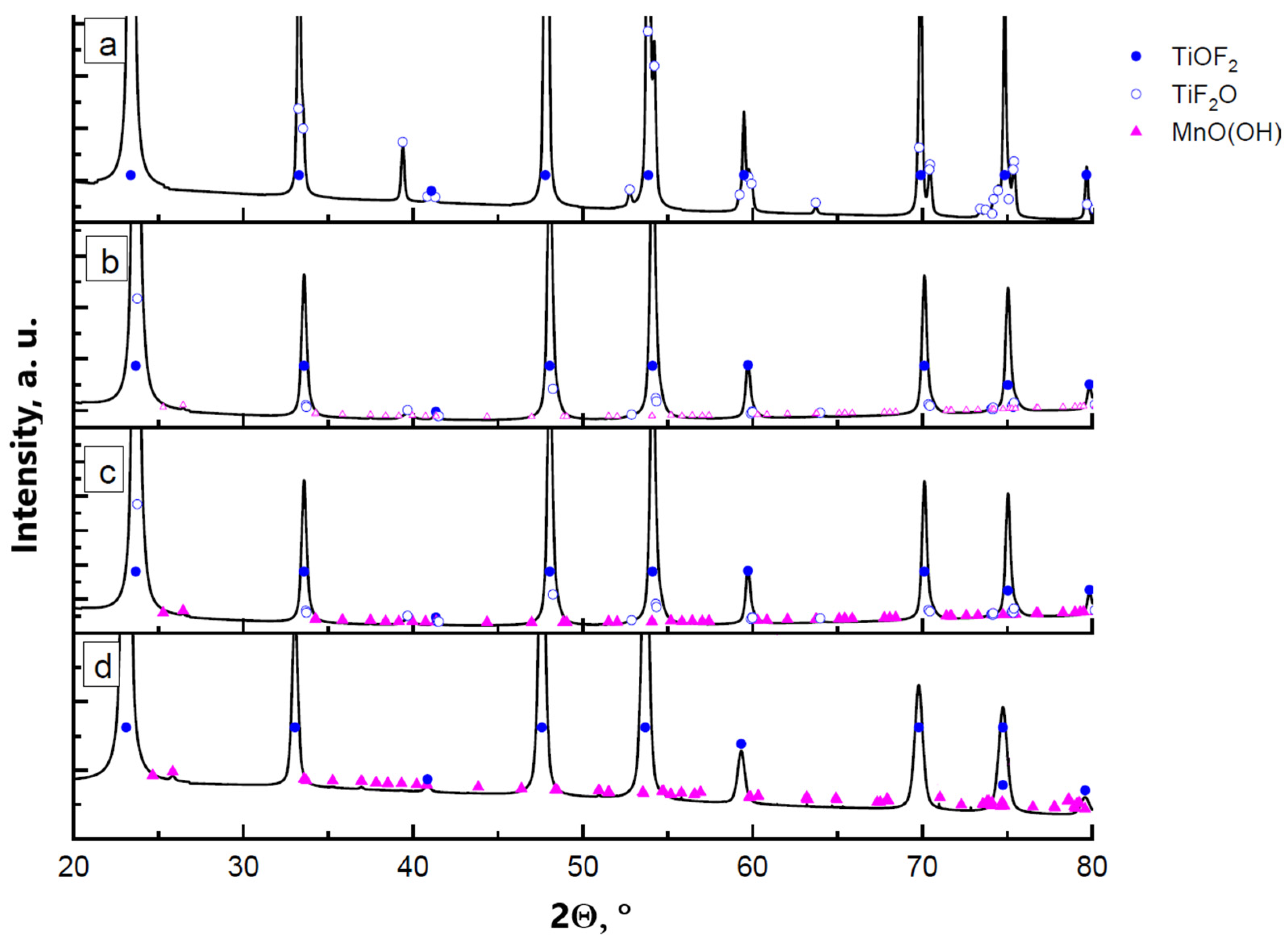
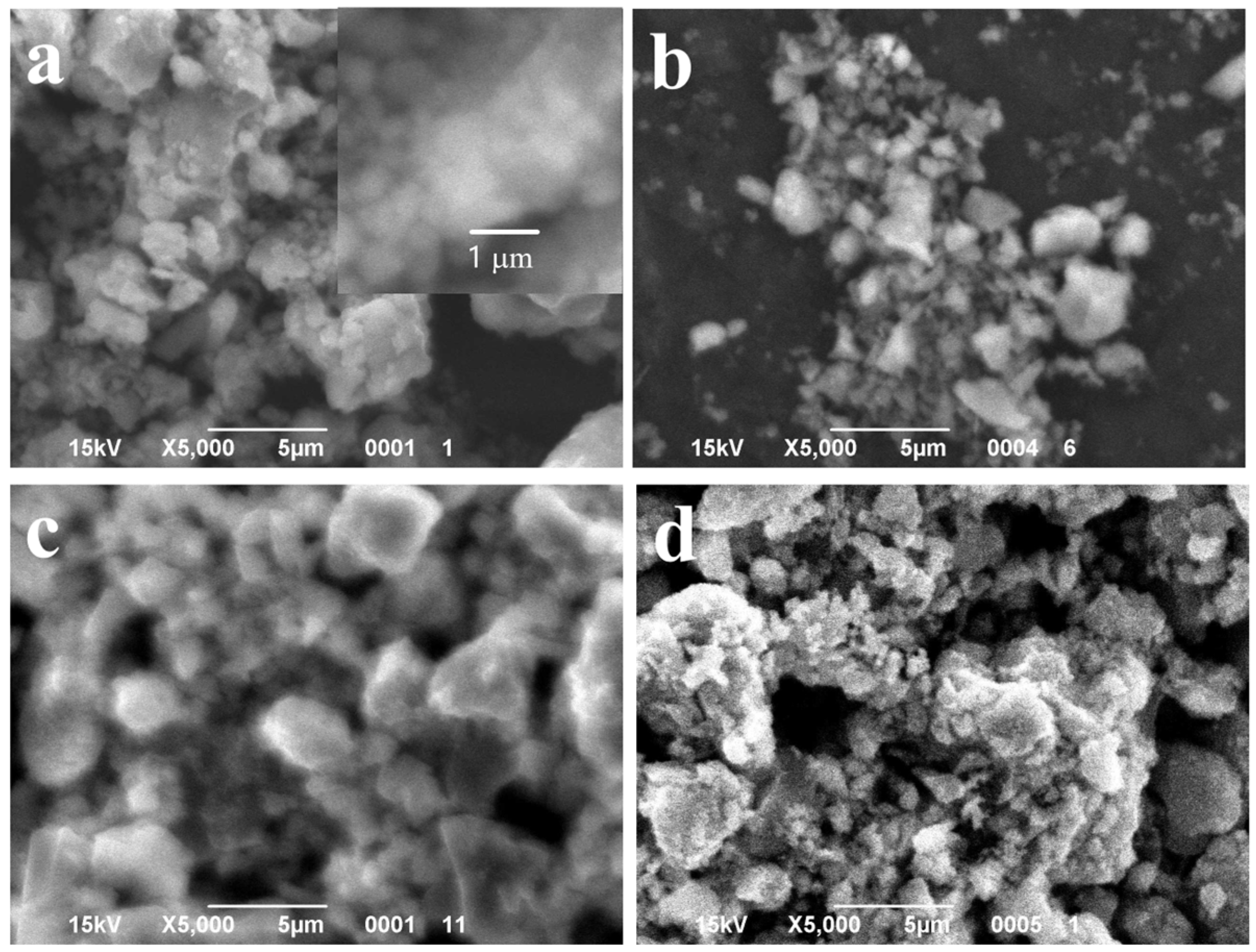


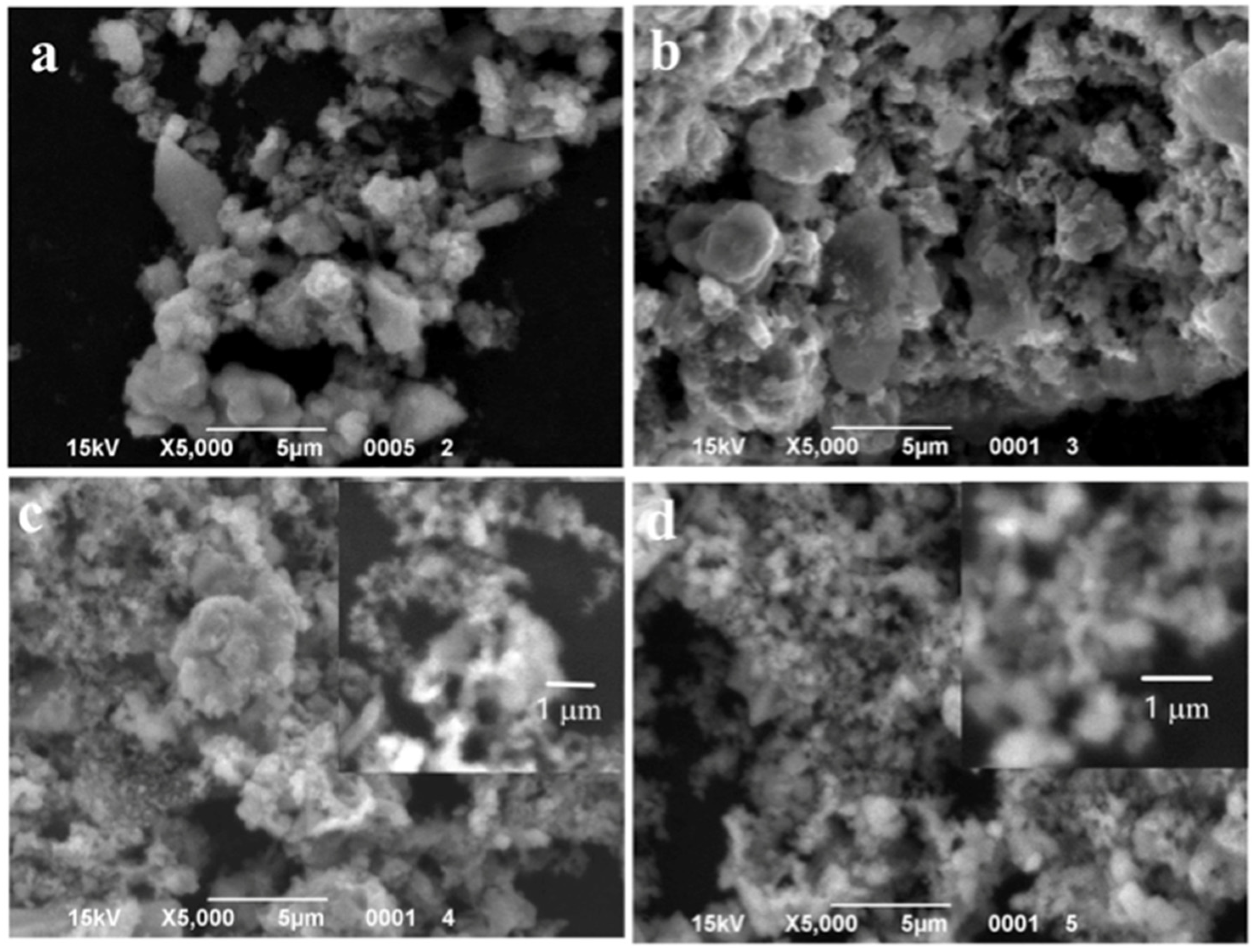
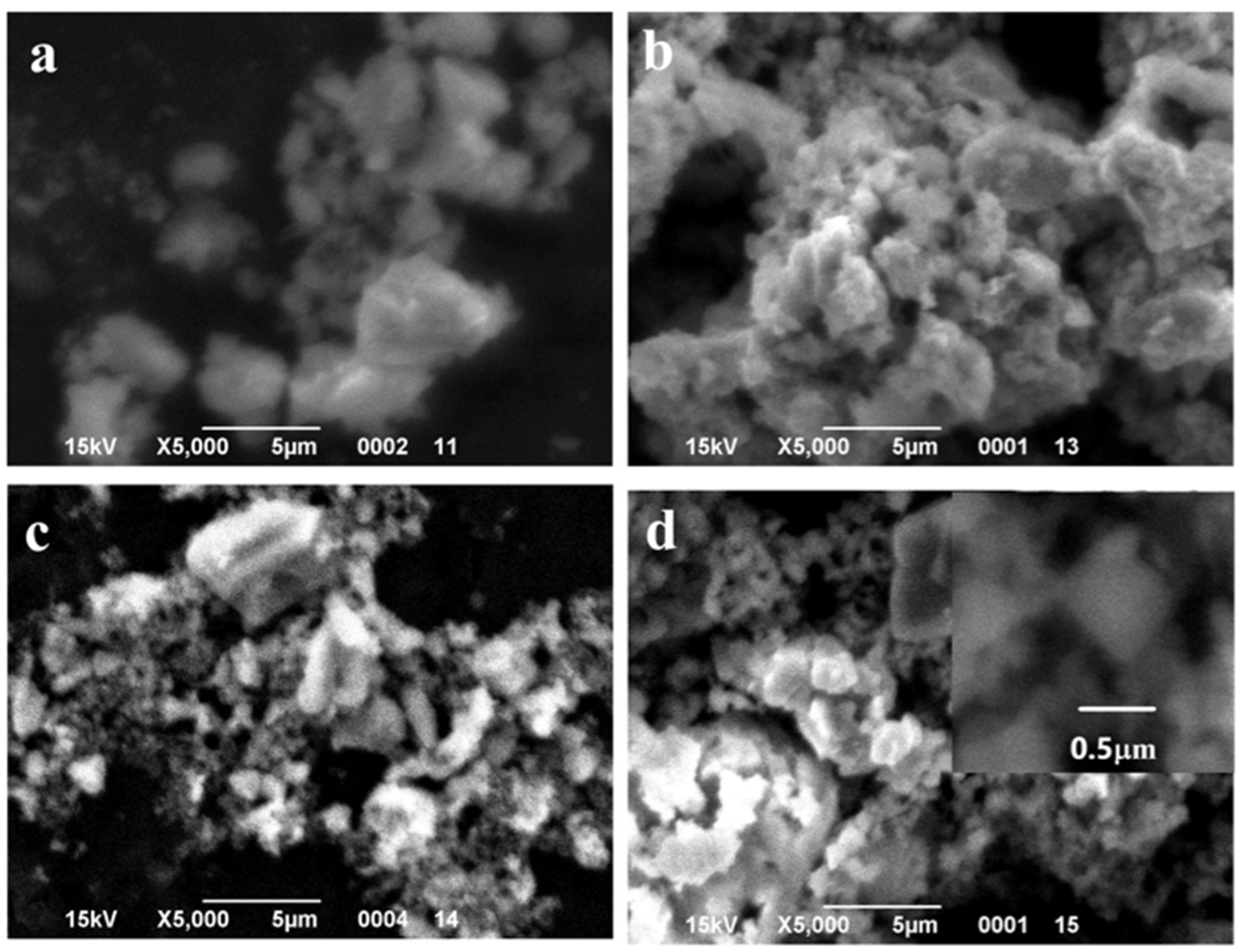

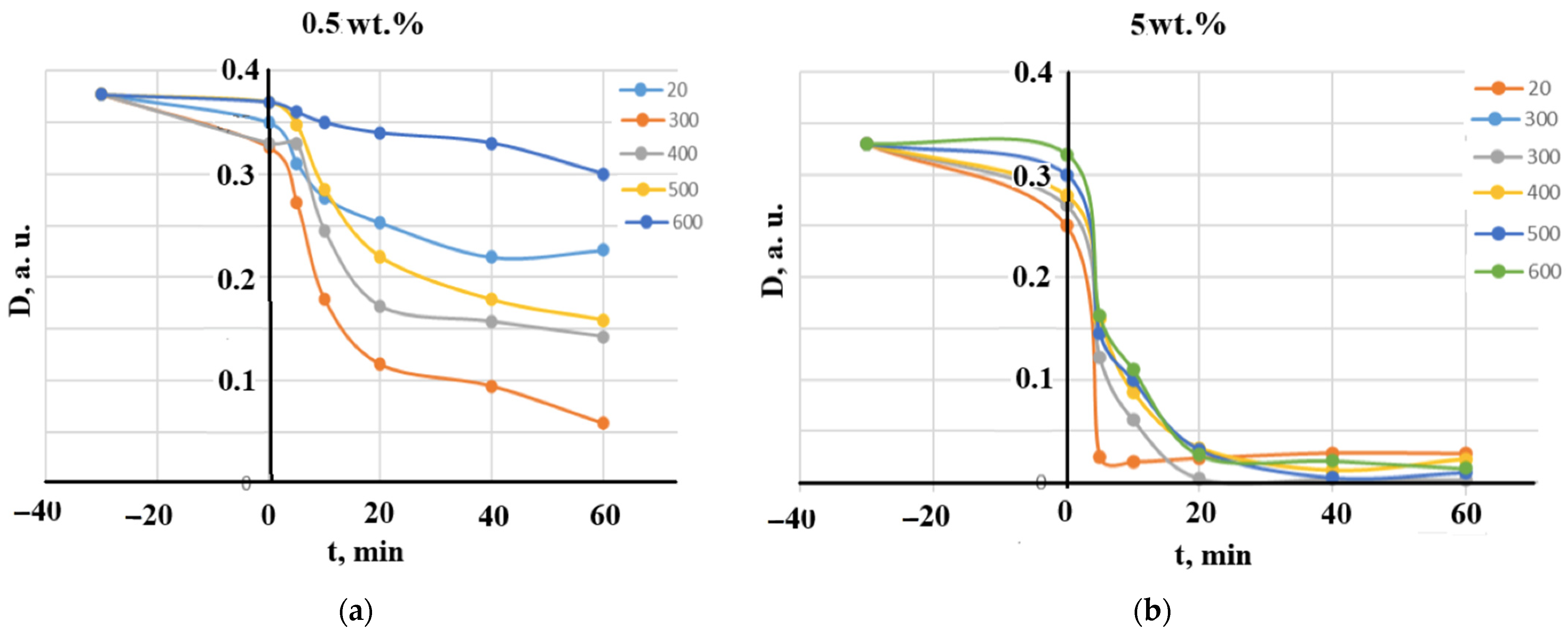
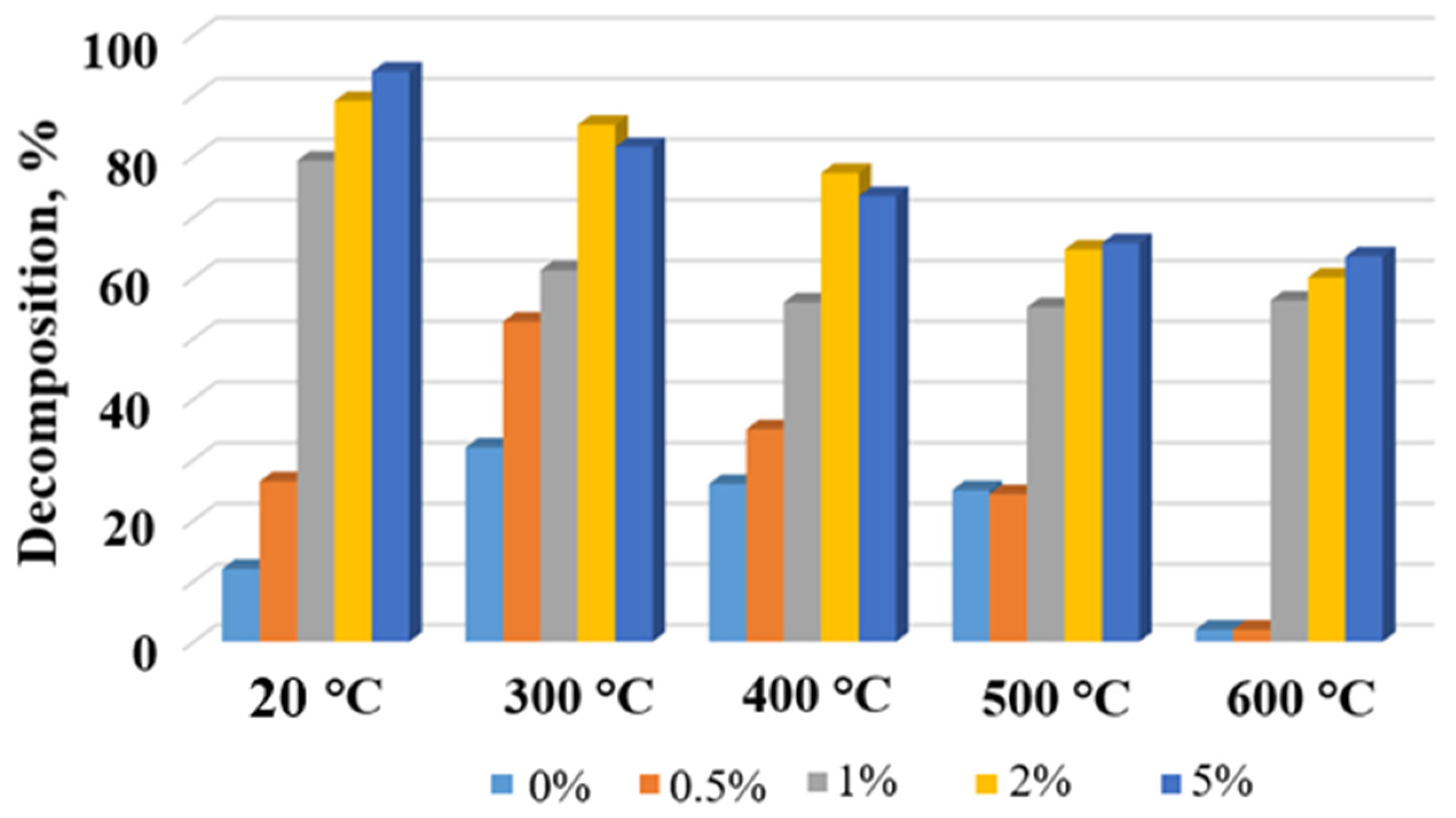

| Sample | T, °C | Content, wt.% | |||
|---|---|---|---|---|---|
| O | F | Ti | Mn | ||
| TiOF2/0.5 wt.%MnO(OH) | 25 | 19.2 | 43.6 | 36.9 | 0.3 |
| 300 | 20.5 | 40.9 | 38.3 | 0.3 | |
| 400 | 29.0 | 25.2 | 45.5 | 0.3 | |
| 500 | 33.6 | 17.5 | 48.5 | 0.4 | |
| 600 | 42.3 | 3.7 | 53.6 | 0.4 | |
| TiOF2/1 wt.%MnO(OH) | 25 | 21.5 | 41.8 | 36.0 | 0.7 |
| 300 | 22.3 | 39.5 | 37.5 | 0.7 | |
| 400 | 26.3 | 30.2 | 42.8 | 0.7 | |
| 500 | 28.5 | 26.9 | 43.4 | 0.8 | |
| 600 | 40.7 | 3.0 | 55.5 | 0.8 | |
| TiOF2/2 wt.%MnO(OH) | 25 | 19.5 | 42.4 | 36.7 | 1.4 |
| 300 | 20.8 | 41.5 | 36.3 | 1.4 | |
| 400 | 24.5 | 34.1 | 39.8 | 1.6 | |
| 500 | 27.7 | 29.4 | 41.2 | 1.7 | |
| 600 | 42.5 | 2.9 | 52.9 | 1.7 | |
| TiOF2/5 wt.%MnO(OH) | 25 | 23.0 | 38.4 | 35.1 | 3.5 |
| 300 | 22.5 | 38.5 | 35.5 | 3.5 | |
| 400 | 23.4 | 32.9 | 40.1 | 3.6 | |
| 500 | 24.0 | 28.9 | 43.2 | 3.9 | |
| 600 | 44.9 | 2.6 | 48.5 | 4.0 | |
| Content of MnO(OH), wt.% | T, °C | Phase Content, wt.% | ||||
|---|---|---|---|---|---|---|
| h-TiOF2 | TiO2 Anatase | TiO2 Rutile | Mn3O4 | Mn2O3 | ||
| 5 | 300 | 74.5 | 24.8 | - | 0.7 | - |
| 400 | 41.4 | 56 | - | 2.6 | - | |
| 500 | 37.9 | 60.1 | - | 2.0 | - | |
| 600 | - | 92.4 | 0.6 | 7.0 | - | |
| 0.5 | 600 | - | 99.7 | - | - | 0.3 |
| 1 | 600 | - | 99.2 | - | 0.8 | - |
| 2 | 600 | - | 98.6 | - | 1.4 | - |
Disclaimer/Publisher’s Note: The statements, opinions and data contained in all publications are solely those of the individual author(s) and contributor(s) and not of MDPI and/or the editor(s). MDPI and/or the editor(s) disclaim responsibility for any injury to people or property resulting from any ideas, methods, instructions or products referred to in the content. |
© 2025 by the authors. Licensee MDPI, Basel, Switzerland. This article is an open access article distributed under the terms and conditions of the Creative Commons Attribution (CC BY) license (https://creativecommons.org/licenses/by/4.0/).
Share and Cite
Sofronov, D.; Frolova, L.; Rucki, M.; Mateychenko, P.; Baranov, V. Effect of Manganese Concentration and Calcination Temperature on Photochemical Properties of TiOF2/MnO(OH). Appl. Sci. 2025, 15, 11847. https://doi.org/10.3390/app152111847
Sofronov D, Frolova L, Rucki M, Mateychenko P, Baranov V. Effect of Manganese Concentration and Calcination Temperature on Photochemical Properties of TiOF2/MnO(OH). Applied Sciences. 2025; 15(21):11847. https://doi.org/10.3390/app152111847
Chicago/Turabian StyleSofronov, Dmytro, Liliya Frolova, Miroslaw Rucki, Pavel Mateychenko, and Vyacheslav Baranov. 2025. "Effect of Manganese Concentration and Calcination Temperature on Photochemical Properties of TiOF2/MnO(OH)" Applied Sciences 15, no. 21: 11847. https://doi.org/10.3390/app152111847
APA StyleSofronov, D., Frolova, L., Rucki, M., Mateychenko, P., & Baranov, V. (2025). Effect of Manganese Concentration and Calcination Temperature on Photochemical Properties of TiOF2/MnO(OH). Applied Sciences, 15(21), 11847. https://doi.org/10.3390/app152111847








